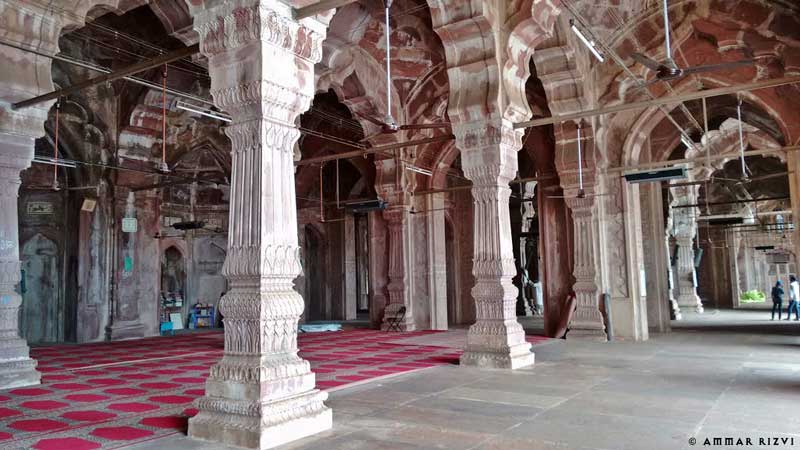
Located by the lake Motia Talab, in the heart of the city of Bhopal in Madhya Pradesh, India, the Taj-ul-Masjid or Taj-ul-Masajit, which stands for The Crown of the Mosques, is the largest mosque in India and one of the largest in the world. The massive structure, made of red stone and spreading over a total area of around 430,000 square feet, is equipped with a trio of white bulbous domes over a long facade flanked by colossal minarets with white marble domes on their top. With close resemblance in design, decoration and architecture to the Jama Masjid of Delhi in India, it is the most impressive monument of Bhopal and is reckoned a famous tourist attraction.

Dost Muhammed Khan, a Pashtun mercenary, founded the state of Bhopal in 1729 and became its first Nawab. However, for more than a century, precisely from 1818 to 1926, Bhopal was ruled by women of the dynasty, who were called Nawab Begum. While the first Nawab Begum was Qudsia Begum, born Udham Bai, Nawab Shah Jahan Begum took over the reins in 1844 at the age of six and for the next 16 years, her mother, Sikandar Begum acted as the regent. However, in her second stint after her mother’s death, she ruled for 33 years, which was probably the beginning of a golden period of Bhopal. She initiated the construction of the Taj-ul-Masajid in the newly-built walled suburb of Shahjahanabad, during the reign of the Mughal Emperor Bahadur Shah Zafar, intending to build the biggest mosque in India. Although the exact year of initiation of construction is unclear, it is estimated to be 1871.

Apart from the mosque, Shah Jahan Begum also undertook a massive building spree, which other than the construction of several palaces and mosques, included various important infrastructures for schools, dams, lakes, a postal system and a railway service between Hoshangabad and Bhopal. However, the spree of construction resulted in a severe fund crunch for which the construction of the Taj-ul-Masajid was suspended temporarily and could not be completed before she died in 1901. Although her daughter, Sultan Jahan Begum, tried to complete the project till the end of her life, she could not do it due to the lack of funds. The work remained suspended and apparently left in cold storage, even when the Princely state of Bhopal was merged with the Republic of India on 1 May 1949.

The incomplete structure of the Taj-ul-Masajid remained neglected and unattended until 1971, when the local Muslim organizations took the initiative and the construction of the mosque eventually resumed under the leadership of Maulana Sayed Hashmat Ali Sahab and Allama Mohammad Imran Khan Nadwi Azhari. Finally, the construction was completed in 1985, almost a century after its inception and a grand entrance gate was put up to mark the boundary and establishment as a whole.

The Taj-ul-Masajid, distinctly reflecting the Mughal architecture, is located amid three water bodies, namely the Munshi Hussain Talab, Noor Mahal Talab and the Motia Talab. Its double-storey gateway with four recessed archways and nine cusped multifold openings leads to a huge courtyard with a capacity to accommodate 175,000 people, equipped with a square shaped tank in the centre, accentuated by the reflection of the pink structure. The marble floored main prayer hall, measuring 15070 square feet (1400 sq m) and equipped with 11 arches that make way to the Qibla wall, is supported by massive pillars, holding 27 ceiling sections through squinted arches of which 16 ceilings are decorated with designed ornamented petal designs. Initially, the entire prayer hall floor was planned to be covered with crystal glass tiles, but the plan was shelved as the Islamic clerics pointed out that the devotees are debarred to see their images while praying. Nevertheless, the marble floored main hall, beautifully decorated with trellised screens, carved arches, wall niches and the Mihrab, undeniably reminds the interior decorations of the Badshahi Mosque in Lahore.

Apart from the Taj-ul-Masajid, the mosque complex also contains a library and a small museum, named after Sulaiman Nadwi, who was instrumental in starting a madrasa in the complex. The library contains around 20,000 books on 28 subjects, offering space for the students to study. Few Crystal Glass floor tiles are exhibited in the museum, which also contains a Crystal glass book stand for reading the Quran, a palm sized Quran, purported to have been written by the Mughal Emperor Aurangazeb and a very old copy of the Quran, believed to be used by him.